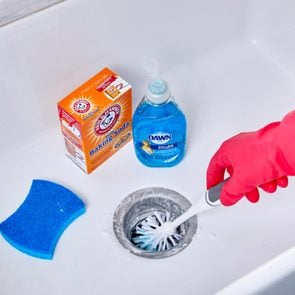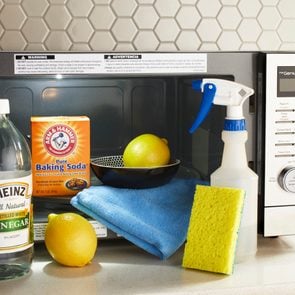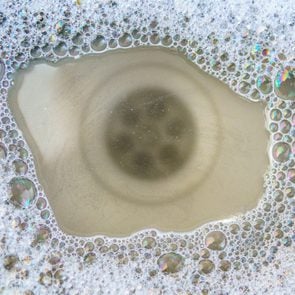How to Use a Self-Cleaning Oven Feature Safely and Effectively
Updated: Apr. 18, 2024
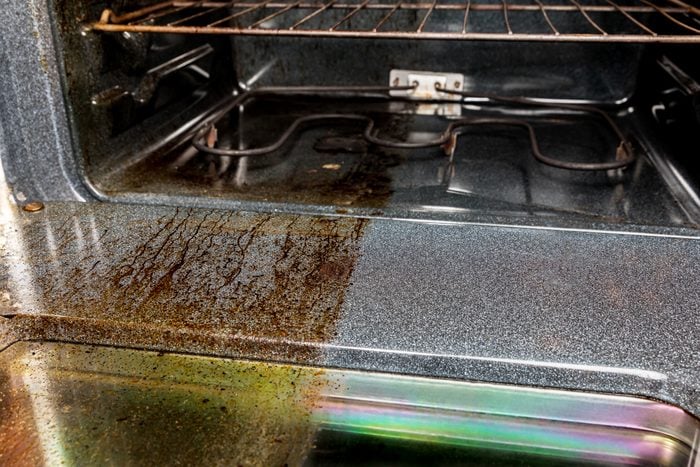
Don't put off this cleaning project any longer! Luckily, self-cleaning ovens do most of the work for you.
Is last night’s lasagna still lingering in the air after your bubbly, cheesy masterpiece nearly set off the smoke alarm? Thinking of getting takeout until you have time to clean the oven? There’s no need to wait. “Self-cleaning ovens help to take a huge load off of heavy cleaning work in the kitchen,” says Nick Webert, senior director of care field service operations at Samsung. That means you can get back to cooking sooner.
If you’re a little wary about using the self-cleaning oven feature, we’ve got you covered. The function is safe and convenient, and it works without harsh chemicals. Reader’s Digest talked to oven experts Webert and Amelia Hensley, director of cooking systems at GE Appliances, to teach you how to clean your self-cleaning oven. It’s easy because (spoiler alert) it basically cleans itself. Let our experts walk you through it, step by step.
Get Reader’s Digest’s Read Up newsletter for more cleaning, humor, travel, tech and fun facts all week long.
About the experts
Reviewed for accuracy by: Ann Russell, TikTok’s “cleaning auntie” and the author of How to Clean Everything. |
On This Page
How does a self-cleaning oven work?
Self-cleaning ovens work like little incinerators, using “very high temperatures to convert baked-on soils into a powder that can be easily wiped away,” Hensley says. How high are we talking? GE’s self-cleaning ovens operate at around 880 degrees, though exact temperatures vary by manufacturer. At those temps, organic material like food and grease essentially turn to ash.
Webert adds that ovens often have two different self-cleaning cycles. “Most models offer high-heat or steam functions as methods to self-clean,” he says. The steam self-clean can be useful for “in-between” cleans, he says, to help remove light soiling.
Is it safe to use a self-cleaning oven?
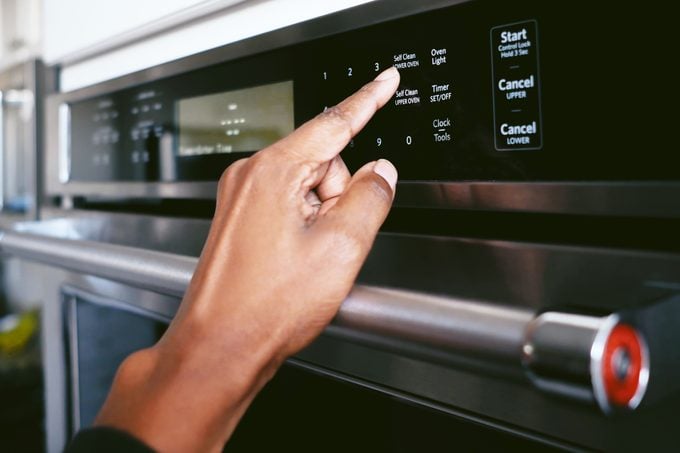
You can rest easy: The self-clean cycle is safe! Ovens with this function are self-contained metal boxes with insulation made to withstand the high temperatures of self-cleaning. In addition, self-cleaning ovens installed in U.S. homes must be listed by an accredited standards organization, like UL or Intertek, which lets you know that the appliance conforms to accepted safety and fire-prevention standards.
So your oven isn’t likely to set the kitchen on fire while it’s running through the self-clean process. But will it affect the air quality in your home? Burning food gives off an odor, as well as small amounts of various indoor air pollutants. People with allergies or asthma may want to vacate the kitchen. For others, Webert and Hensley suggest running the exhaust hood or opening a window.
And remember: Just because a self-cleaning oven is safe doesn’t mean it’s foolproof. Make sure at least one person stays home during the process. “Self-cleaning is a safe feature and function. However, it is never advisable to leave the house with an oven running,” Webert says. “The same rule that applies to the likes of leaving a candle burning or cooktop on when you are not home [applies to a self-cleaning oven].” In other words: Don’t do it.
What to do before you start
Because your oven reaches temps nearly twice as high as usual, it’s important to follow basic safety rules. For one thing, never use any commercial oven cleaners in your self-cleaning oven, Webert says. Ditto for oven liners and aluminum foil. He says these materials can harm your oven’s protective interior coating if exposed to the self-clean cycle’s high temperatures.
Safe and smart homeowners follow the tips below before using the self-clean function.
- Read the manual. There’s no need to guess what works best for your oven brand—manufacturers walk you through self-cleaning step by step. “Make sure you follow the instructions in your use-and-care manual when using the self-clean feature,” Hensley says.
- Block out some time. The entire process could take several hours, Webert notes. Look at your cleaning schedule and choose a time that’s right for you, whether it’s “first thing in the morning or after the last meal of the day,” Hensley says.
- Protect pets. Keep pets away from the kitchen (self-cleaning ovens get hot). Webert says birds are particularly sensitive to the odors, so move them to a well-ventilated alternate location.
- Remove combustibles. Move tea towels, food containers, utensils and other flammable items from the top of your stove.
- Open a window. Webert admits the burning residue can smell, but he says a little air circulation from an open window or range hood can help.
How to use the self-cleaning oven feature
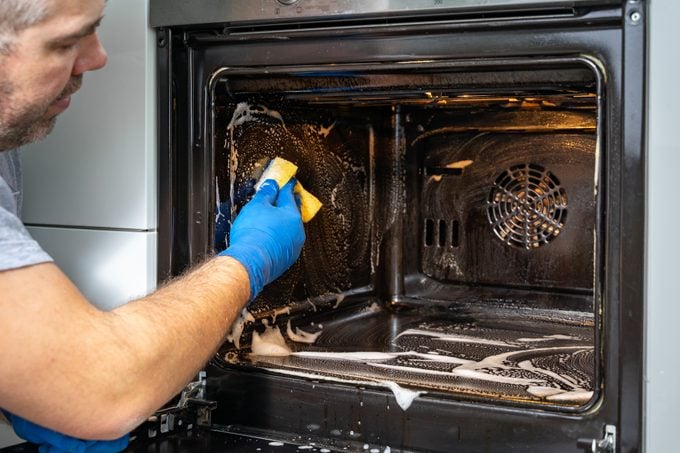
Your oven’s self-clean feature doesn’t let you off the hook, cleaning-wise. Not only do you have to prep your appliance by wiping it down, but you also need to clean your oven of the resulting ash. The process outlined by Hensley and Webert is easy to follow, but don’t forget to check your user manual first!
Supplies you’ll need
- Sponge or microfiber cloth
- Dish soap or white vinegar
- Vacuum (optional)
Directions
- Remove racks, pans, trays and utensils. “Some racks can be left in the oven during the self-cleaning cycle, but others need to be removed to avoid tarnishing—check your use-and-care manual to confirm,” Hensley says.
- Clean out debris and grease. Wipe down the interior with a cloth or sponge to remove any grease or oil spills. Use dish soap or vinegar if needed, never a commercial cleaner. Hensley likes using a vacuum to quickly remove crumbs.
- Set the oven to self-clean mode. “Run the maximum self-clean cycle time allowed by your oven,” Hensley says. Depending on your oven make and model, you may need to physically lock the door first by sliding a bar near the door handle. Other oven doors lock automatically when you choose the self-clean cycle.
- Wait. Self-cleaning ovens can take three hours or more to complete a cycle. Once it’s done, “give yourself some distance,” Webert says. “It will be extremely hot, and it is important to avoid any potential injury.”
- Wipe out the ash. Once the oven has cooled and the door unlocks, wipe down the sides and bottom of your oven with a damp cloth to remove the powdery residue.
Tips for using a self-cleaning oven
Running your oven’s self-cleaning feature may not be the simplest of all your cleaning tasks, but you can make the job less of a pain by following the experts’ advice below.
- Clean up spills as they happen. Hensley says cleaning the oven will be less of a chore if you clean as you go.
- Clean your oven door’s glass window regularly between self-cleanings. Hensley recommends soaking a cloth in hot soapy water and placing it on the window. After 10 minutes, scrub and rinse.
- Rinse oven racks outside with a garden hose or soak them in hot, soapy water while the cycle is running. One thing to watch out for? Some racks “come with a special lubricant for the ball bearings in the sliding mechanism,” Hensley says. So avoid getting soapy water inside.
- Never force open the oven once it’s locked for a self-cleaning cycle. “You can damage any locking system your appliance may have,” Webert says. “It could also force you to start the process over again.”
FAQs
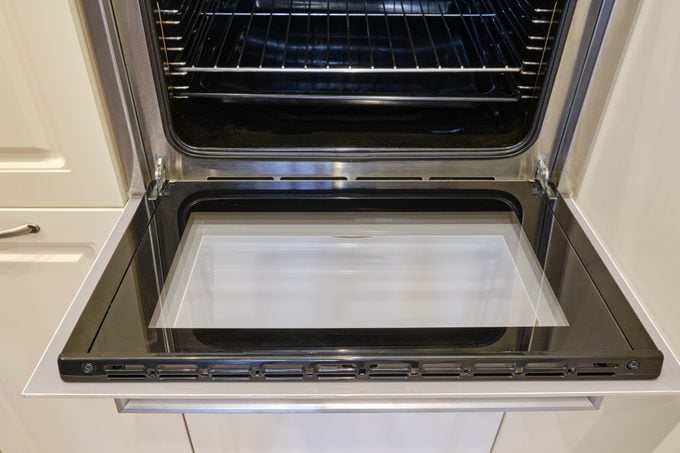
How often should you self-clean your oven?
At least once or twice a year, according to Hensley. A good time to start is “after heavy oven use, such as after baking for a party or holiday gathering, or after messy, splatter-prone bakes,” she says. For families that cook most meals at home, Hensley suggests using the self-cleaning oven feature four or five times a year instead of once or twice.
What happens if you turn a self-cleaning oven off early?
Temperatures inside a self-cleaning oven can be close to 900 degrees. If you turn the self-cleaning cycle off early, you’ll have to wait for it to cool down enough for the door to unlock. Cleaning won’t be complete, and you’ll probably be left with a half-baked-on mess that will cool and be even harder to clean next time. Stop the cleaning cycle only when really necessary (such as in the case of a fire), and never force the door lock. You could do serious damage to your oven.
How long does a self-cleaning oven take to cool down?
Between 30 and 90 minutes, according to GE. Other manufacturers, models and cleaning settings may vary.
What is the white stuff in my oven after self-cleaning?
That’s the carbonized (aka burnt) food from the cleaning process. Self-cleaning ovens work by blasting food spills with intense heat, and that powdery, white ash is all that’s left once the cycle completes.
Hensley says appliance engineers test self-cleaning ovens on common messy, baked-on spills, including fats, proteins, sugars, acids and starches. Whatever you’ve spilled in your oven, it’s in that white residue.
Why trust us
At Reader’s Digest, we’re committed to producing high-quality content by writers with expertise and experience in their field in consultation with relevant, qualified experts. For this piece, Ally Childress tapped her experience as a licensed electrician and seasoned home and cleaning journalist, and then Ann Russell, TikTok’s “cleaning auntie” and the author of How to Clean Everything, gave it a rigorous review to ensure that all information is accurate and offers the best possible advice to readers. For this piece, we relied on reputable primary sources, including professional organizations and academic institutions as well as our writers’ personal experience. We verified all facts and data and backed them with credible sourcing, and we will revisit them over time to ensure they remain accurate and up to date. Read more about our team, our contributors and our editorial policies.
Sources:
- Amelia Hensley, director of cooking systems at GE Appliances; email interview, Jan. 9, 2024
- Nick Webert, senior director of care field service operations for Samsung Electronics America; email interview, Jan. 10, 2024

